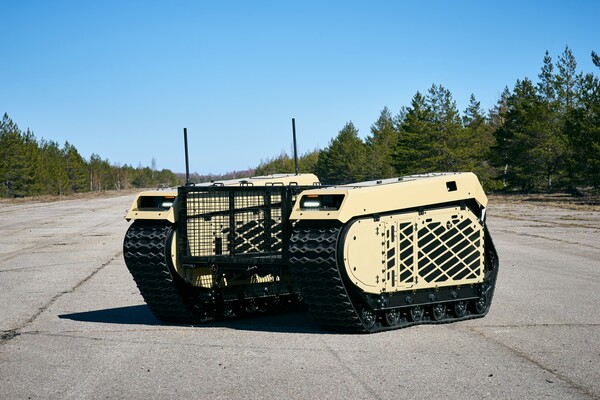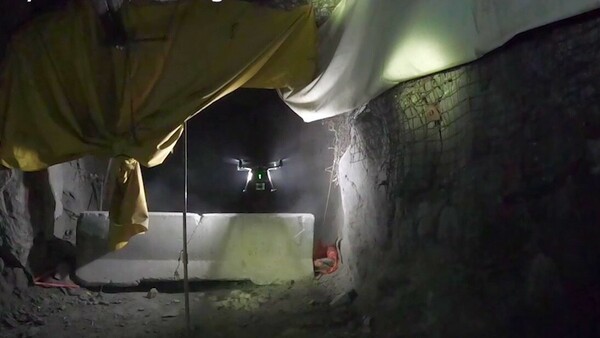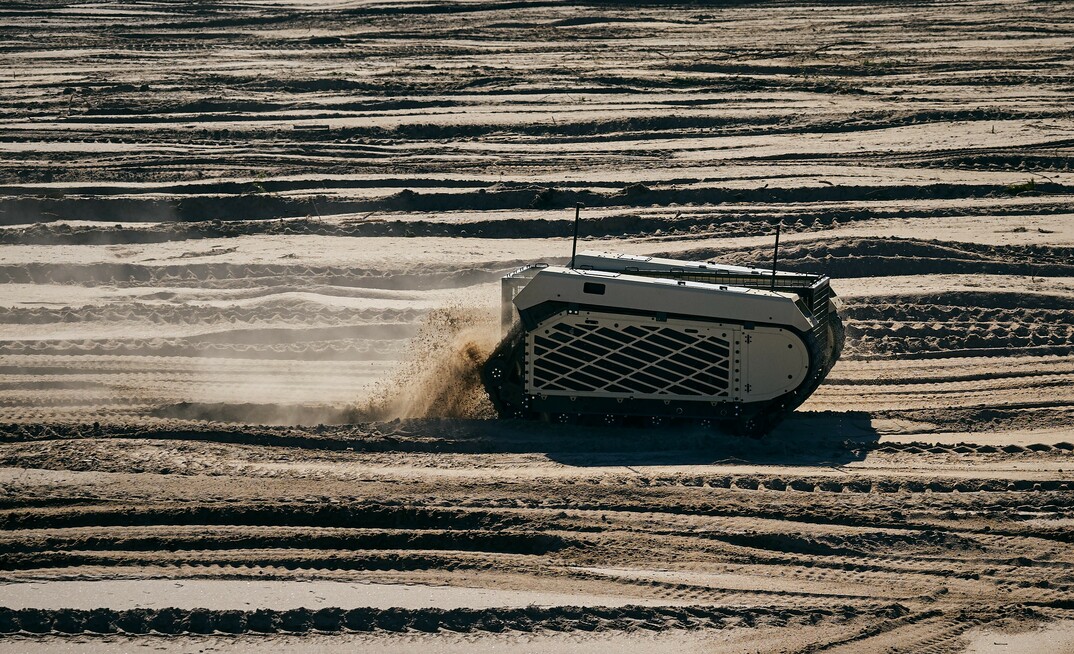Sometime in the future, it will be robots, not people, toiling underground hauling ore to the surface.
Equipped with a bevy of sensors, one of those robots finds its way from a stope blasted just an hour ago to a remuck station where it drops off another load of ore.
Along the way it comes upon a haulage bot at a T-junction. The hauler stops before the ore bot is even in sight, letting it pass; part of a finely tuned orchestration of efficiency and hierarchy that keeps the robots moving.
Because people are no longer working underground, the mine itself has changed its shape and form. In the same way that the timbers and carbide lamps of a previous generation are familiar to the contemporary miner, while still very different, the automated underground mine of the future is recognisable, if a bit out of phase.
This environment has been shaped by the robots scuttling through its passages, not by the requirements of an environment populated by people. No longer do vehicles need passenger cabs. Whatever doors exist, don't need to cater for human access. There's no need to worry about a miner bumping their head, because none of the miners has a head. There are no lunch rooms, because robots do not eat. Instead, they charge their batteries in bays.
With the workers powered by electric motors, and without lungs, the robotic mine needs much less oxygen and ventilation. The roar of fans isn't absent entirely, but is more of a gentle hum. Poisonous gases aren't the concern they once were, and the armoured exterior of a robot isn't susceptible to damage in the way a human can be wounded, so safety standards have shifted.
This mine is still far in the future. It is a sci-fi vision of the underground environment. But right now, the industry is moving toward this vision, taking small steps toward a robotic future. How far away is it? Well, that depends on a lot of things.
What it will take
Barring some major disaster that forces widespread change throughout the industry, Colorado School of Mines researcher Professor Andrew Petruska believes we may see fully automated underground mines in 15-20 years.
The key now is proving robots can work in the underground environment, he says.
South Africa is a prime location for the expansion of automation to a wide scale, Petruska says. Because the mines there are some of the deepest in the world, there will come a time when it makes more sense to push forward with automation than continuing to try achieving results with people.
"You're going to see it there first, simply because the conditions are getting to the point where people just can't survive to do the mining," he says. "There's still good ore, and they want to go deeper, and I think they're going to get to a point where the only way they can go deeper is through automation."
The shorter term is likely going to see a slow transition toward automating discrete tasks, rather than full automation.
The obvious place to start is in areas of the mine where people can't go. Ore passes, open stopes and other areas of the mine where ground control procedures can't be put in place give robots the ability to go in and do a job people can't.
Robotics right now
Based in North Bay, Canada, SafeSight makes a number of semi-autonomous robots for surveying in dangerous areas of an underground mine. SafeSight's president Mike Campigotto says his company has found that automation is enabling it to make better use of its surveying robots by making them easier to operate.
The company makes two main types of drones, wheeled or tracked robots much like a radio-controlled car and a flying four-rotor drone. All carry a variety of sensors, including LiDAR and HD cameras. With the flying drone in particular, automation makes for much easier use. The operator is able to take it out of its case, switch it on and then set a hover level where the drone will hold altitude, Campigotto says.
"Once I have that hover level set, now I'm dealing in two dimensions

An operator does pre-flight checks on one of SafeSight's drones. Partial automation of the robot's flight controls means training times are greatly reduced, and makes the drones easier and safer to fly. Photo: SafeSight
— forward and backward, left and right. You don't have to use both sticks," he says. This removes the complexity of flying something that can be difficult enough in open spaces, made much more so in the limited underground environment.
With the drone managing the hover, he says: "It's like the difference between flying a helicopter and driving a car. That simplification now means that the training cycle is very short to be proficient enough to get value out of the technology."
In addition to flight stabilisation, the drones are also equipped for object detection and avoidance. When the drone detects it is about to hit something, it stops and alerts the operator.
One of the advantages of having the drones only partially automated is it can be in operation around people, without it being necessary to build shelters or have miners leave an area when one is in operation. If part of a unit's autonomous programming fails, the operators must be somewhere protected. But keeping a person in command of its operation means someone is always in control if there is an issue.
"So they at any time have full control over the unit, which then simplifies the operation. And really makes sure that at all times, that flying lawnmower is under total control of the operator," Campigotto says. "The operator can hit the kill switch or change the trajectory of that unit."
Modular robotics
The Estonian company Milrem Robotics has developed a robotics platform that can be modified for all sorts of industrial applications. Its platform is capable of minesweeping and removal on the battlefield in one application, and brush clearing and tree planting in another.
Mart Noorma, Milrem's director of science and development, says that in some ways, the underground mine makes an ideal environment for automated robots.
The fundamental problem with robots is while they are very good at specialised tasks, they are essentially incapable of operating outside those parameters. Self-driving cars are still far from ready because of the complexities involved in driving. It is more than keeping the car going in a straight line; it's about identifying all sorts of risks - cyclists, pedestrians, other vehicles - and avoiding them. These are things that the human brain is well suited for, and is able to process without much difficulty. Getting robots to perform the task, on the other hand, is still very complex.
But stick an automated robot in a section of an underground mine where people are unable to go, and its tasks become simpler. There is no need to worry about the possibility of hurting someone.
"It's not like street cleaning in downtown Manhattan, where your main concern is to be safe for people around. In the mine, you can just tell people, ‘Don't go there, robots work there,'" Noorma says. "And you save hundreds of millions of dollars of investment into very wise safety systems. You don't need it because you just tell people not to go there."
The same principle applies to the physical environment of an underground mine. The robot doesn't have to deal with the high speeds of, for example, highway driving, or the complex task of identifying obstacles in a forest or a field. It is difficult for a robot to easily tell the difference between brush and grass that can be driven over, or grass that is hiding a rock or some other serious obstacle, Noorma says.
For a robot working underground, the environment makes it easier to distinguish between what is an obstacle and what isn't.
"And you'd know what to expect. It's a fixed operating area, so you sometimes operate years [in the same area]. And that means you can install additional beacons for navigation or radio relays to extend your radio communication in underground tunnels," he says.

By making its platform modular, Milrem is able to offer their Multiscope robot for a variety of different applications. By putting the all the robot's control and power functions inside the track assembly, the company is able to keep the centre clear to be retrofitted by the customer. Photo: Milrem Robotics
Humans in the loop
For most applications, there will need to be some level of human intervention. The key is figuring out how much automation is required to have the investment in the technology make economic sense.
There are automated systems with humans in the loop, where people are actively providing input and making decisions for the system, which is automating more routine tasks.
Then there are systems with humans in the loop, where the robots are left to work on their own, only asking for human intervention when they run into some unexpected situation.
A system with humans out of the loop completely, unable to intervene at any point in the process, is something more akin to Skynet of Terminator fame, Noorma says, which is not what anyone wants.
It is possible now to have one operator overseeing, for example, several haul trucks at once that only require occasional intervention to keep the operation running.
But there are areas of the mine where it's not possible or desirable to bar people entirely while robots are operating autonomously. To make that possible, research is being done to ready safety systems for the task. Colorado School of Mines' Professor Sebnem Duzgun is working on finding where the gaps are when machines and people interact.
"One of my research areas is creating an autonomous mine environment in virtual reality and asking people to interact with certain robotic operations and try to identify potential hazards," Duzgun says. "Designing the new mining system in a digital terrain model and doing some simulations before establishing the system is critical."
Managing uncertainty
Another important aspect of improving autonomy is understanding uncertainty underground. While it's true the area is well defined in many ways and easy to navigate through the established parts of a mine, when going into a freshly blasted stope, or other area under active development, the environment itself is an unknown.
"If we have more data we try to understand the phenomena, for example, a roof-fall hazard is related to geology and we never have a full understanding of the geology," Duzgun says. "We have some understanding, but at a local mine scale, it is not always the case."
This makes operations more difficult because unlike a manufacturing setting, where there is very little uncertainty, the mine is full of uncertainties that can be difficult to quantify. What's required, she says, is to give operators and managers the ability to make quick decisions with what is known, and let people with the knowledge and experience make the necessary judgement calls.
Proving the concept
Right now, the industry is on the cusp of really jumping into automation. Much of the technology is out there being used in other industries, now the key is proving to miners that the economic benefits of automation are worth the investment risks of new technologies.
"To get this technology underground you need to prove it. In a low-risk manner, something that definitely does not impede operations," Petruska says. "And then once you build their level of confidence in the technology, then they're going to start asking questions like, ‘Okay, how can I put this in the operations setting and use it to help us make more money?'"
We may be several decades away from fully automated mines, but the industry is taking its first steps toward that future now. Science fiction is day-by-day becoming science fact. The economics of deeper, more dangerous mining, coupled with the step-by-step adoption of semi-autonomous solutions will bring the industry into its robotic future.
The future of mining does not seem that far away after all.

The SafeSight drone's pilot assist automation simplifies the task flying through difficult underground obstacles, even in difficult conditions. This gives mines the ability to get accurate survey data and HD video to inspect damaged or mothballed areas of the mine. Photo: SafeSight
























